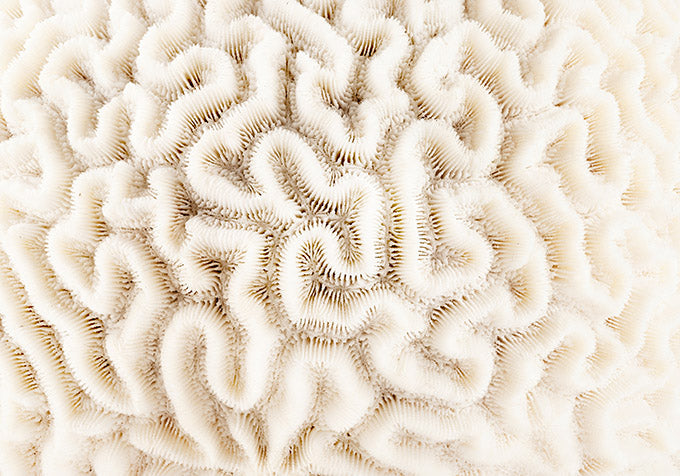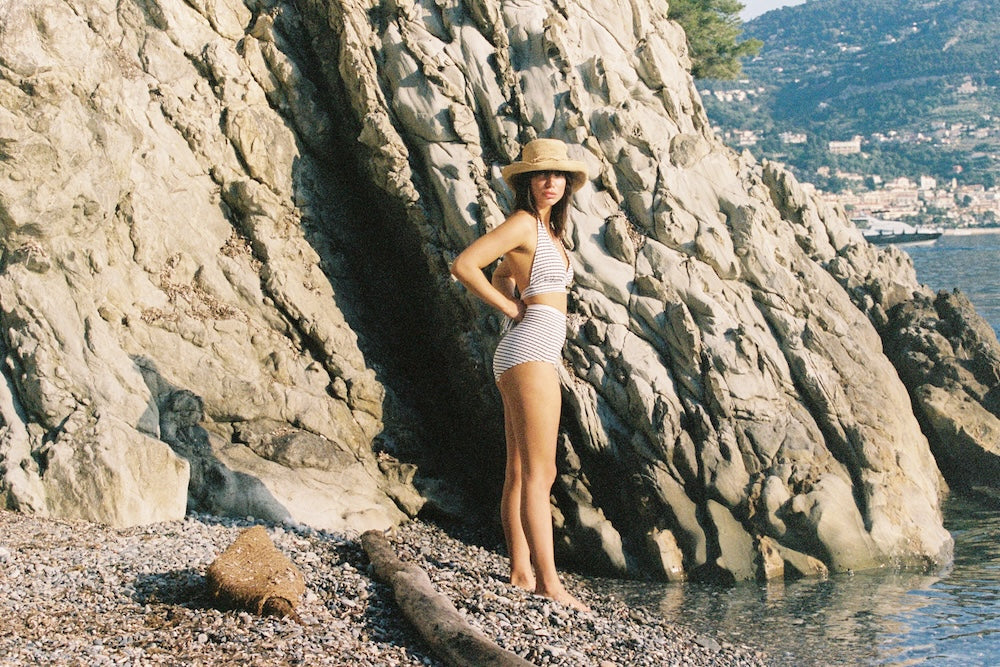One of the greatest wonders of the natural world, coral reefs are thought to have first appeared in our oceans 500 million years ago.
However, we are at risk of losing these ancient treasures. Damaging environmental factors are compromising the corals’ ability to grow and thrive, placing them under threat. Currently, as much as one third of reef building corals are at risk of extinction, and scientists predicted that all corals will be threatened by 2050, with 75 percent facing high to critical threat levels.

Salvation is needed and we believe we have a responsibility to act. Kōraru is proud to be partnering with Coral Reef Alliance (CORAL), a non-profit, environmental NGO dedicated to the conservation of coral reefs worldwide. CORAL works with local communities to help reduce environmental stressors, and is undertaking pioneering research to future-proof our coral reefs. Our collaboration sees $5 from every swimsuit donated to CORAL's mission to keep our planet’s corals thriving for generations to come and prepare them for rising ocean temperatures.
We sat down with CORALS’ associate development manager, Megan Crain, to discover more about our endangered coral reefs, and how as a global community we can help save them.
Kōraru: What exactly is a coral reef?
CORAL: Coral reefs are built by, and made up of, thousands of tiny animals—coral “polyps”—that are related to anemones and jellyfish. Polyps can live individually or in large colonies that comprise an entire reef structure. The variety of coral shapes and sizes largely depends on the species; some corals form hard, pointed shapes, while others form soft and rounded shapes. The shape of coral colonies also depends on the location of the coral. For example, in areas with strong waves corals tend to grow into robust mounds or flattened shapes. In more sheltered areas, the same species may grow into more intricate shapes with delicate branching patterns.
K: Where are coral reefs found?
C: Most reefs are located between the Tropics of Cancer and Capricorn, in the Pacific Ocean, the Indian Ocean, the Caribbean Sea, the Red Sea, and the Persian Gulf. Corals are also found farther from the equator in places where warm currents flow out of the tropics, such as in Florida and southern Japan.
K: Coral reefs are one of the planet's greatest natural beauties, but why are they such an important part of the marine ecosystem?
C: Coral reefs are unlike anything else on the planet. Although they cover less than 0.1 percent of the earth’s surface, coral reefs are the most biodiverse marine ecosystems in the world. In addition to providing valuable habitat for fish and other animals, they are incredibly beautiful, with seemingly infinite structures and growth forms. Their intricate crevices and three-dimensional structures shelter many species of fish, marine worms, crustaceans, clams, and many other animals and plants, all of which play a unique and vital role in the coral reef ecosystem.
K: How do coral reefs sustain communities, both locally and globally?
C: Coral reefs are an important food source for the people who live near reefs, and as nurseries, are vital to the world’s fisheries. Many of the compounds now being used in human medicines, including some that treat cancer, are found on coral reefs, with probably many more yet to be discovered.
Coral reefs help humans in many other ways too: generating tourist dollars for communities, and—especially important in our changing climate—acting as natural barriers against storm events like hurricanes, typhoons, and even tsunamis.
K: What are the biggest threats to coral reefs?
C: Today, coral reefs face multiple stressors at different scales. When global threats like warming waters combine with direct threats like overfishing and water pollution, it severely compromises the ability of corals to grow, reproduce and thrive. As much as one-third of all reef-building corals are at risk of extinction.
K: Can you tell us about CORAL's evolution approach to coral conservation?
C: Our scientific research tells us that corals reefs can adapt to the effects of climate change. If we keep corals healthy in strategic, ecologically connected networks around the world, we can create the conditions under which evolution can help rescue reefs.
CORAL works at multiple scales from local to global to address reef threats. At a local level, when we reduce direct threats to reefs—such as pollution, overfishing or unsustainable tourism—reefs are healthier and more capable of withstanding the effects of climate change, like bleaching and ocean acidification. At a regional and global level, we help reefs by establishing Adaptive Reefscapes – networks of healthy reefs that enable corals to adapt to climate change because they are diverse, connected and large.
K: As a swimwear brand, we believe it's essential to give back to the ocean. How will our collaboration help?
C: Donations to CORAL support our coral conservation work all around the world. We work collaboratively with communities to reduce direct threats to reefs in ways that provide long-term benefits to people and wildlife. Your donation will go where corals need the most help—from supporting wastewater treatment programs to restoring watersheds to stop land-based pollution to combating overfishing.
K: Many coral reefs around the world - including the Great Barrier Reef – are in critical condition, how long have we got to save them?
C: We need to act swiftly to reduce local threats to reefs so they have the time and space to adapt to the rapidly evolving global threats from climate change. This will ensure that all reefs will be near a source of healthy, well-adapted corals, which can help repopulate former reef areas. We will achieve this goal by executing two complementary strategies: firstly, By directly implementing ecologically connected networks of healthy reefs. Secondly, turning science into action globally through alliances.
K: Coral reefs are the world's most economically valuable natural asset. Why?

C: Healthy reefs support local—and global—economies. Through the tourism industry and fisheries, coral reefs generate billions of dollars—and millions of jobs—in more than 100 countries around the world. Studies show that on average, countries with coral reef industries derive more than half of their gross national product from them. The annual value of the ecosystem services provided by coral reefs to millions of people is estimated to be over $375 billion. For residents of coral reef areas who depend on income from tourism, reef destruction creates a significant loss of employment in the tourism, marine recreation, and sport fishing industries.
K: Speaking of tourism, how can we visit corals without causing harm?
C: By observing earth-friendly traveler best practices such as:
Choosing a hotel that outlines their sustainability policy on their website.
Avoiding all inclusives, as the economic benefit of these resorts do not always trickle down to the local communities.
Choosing boat operators that use moorings instead of anchoring on the reef.
Opting for a reef-safe sunscreen that does not contain oxybenzone, oxtinate, or octocrylene.
Avoiding coral souvenirs.
Eating only local seafood that has been sustainably caught.
Using a surface marker and selecting points of exit and entry that avoid the reef.
Avoid using gloves and kneepads in coral environments.
Practise proper fin techniques to avoid kicking coral or stirring sediment.
Swim in a horizontal position without using your arms when snorkeling.
When diving, avoid using photography or video equipment.
Never touching, standing or resting on corals and maintaining a safe distance at all times.
K: What does the world look like without coral reefs?
C: Without coral reefs, over 25 percent of marine biodiversity would suffer from habitat loss and there would be an immediate impact on water quality—as corals are essential for nutrient recycling. Humans would also be impacted with local communities that rely on coral reefs for food and income, experiencing economic turmoil and hunger.
K: What simple measures can we take in our everyday life to help conserve coral reefs?
C: The good news is you don’t have to live near an ocean to protect coral reefs. You can start by changing your consumer habits, and then take it a step further by advocating for higher level change. The first step is becoming a more conscious consumer—embrace the reuse movement! Next, take it to the next level by becoming a change advocate. Push for policies that limit waste and curb greenhouse gas emissions. Use your voice as a voter to sign petitions. Let your government representatives know you care by writing letters and making phone calls. And take it corporate—put pressure on corporations to adopt more environmentally friendly practices and reduce the impact of their production and packaging.




